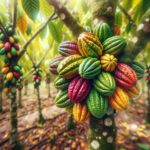The cultivation of cacao (Theobroma cacao) faces various threats that can affect both yield and production quality. Pests and diseases represent one of the most significant challenges for cacao producers. Effective management of these threats requires a combination of constant monitoring, proper agricultural practices, and the implementation of integrated control methods. Below are the main pests and diseases affecting cacao and the most effective strategies for their control.

Main Pests of Cacao
1. Cocoa Pod Borer (Conopomorpha cramerella)
Description
The cocoa pod borer is one of the most destructive pests for cacao. The larvae of this insect bore into the pods, directly affecting the cacao beans.
Symptoms
- Pods with perforations and internal galleries.
- Premature pod drop.
- Malformed or low-quality cacao beans.
Control Strategies
- Monitoring: Installation of pheromone traps to detect and monitor the presence of adults.
- Biological Control: Introduction of parasitoids like Trichogramma spp. that attack the borer’s eggs.
- Chemical Control: Application of specific insecticides in case of severe infestations, always following integrated pest management (IPM) recommendations.

2. Cacao Thrips (Selenothrips rubrocinctus)
Description
Thrips are small insects that feed on the sap of leaves, causing significant damage to cacao foliage.
Symptoms
- Silvery or whitish spots on leaves.
- Deformed leaves with curled edges.
- Loss of vigor in plants.
Control Strategies
- Monitoring: Regularly check the underside of leaves to detect the presence of thrips.
- Biological Control: Release of natural predators such as Orius spp. that feed on thrips.
- Cultural Control: Maintain field cleanliness by removing weeds that may serve as refuge for thrips.

3. White Mite (Polyphagotarsonemus latus)
Description
This mite feeds on young cacao leaves, causing deformation and reducing overall plant growth.
Symptoms
- Young leaves curled and deformed.
- Reduced growth and plant weakening.
- Appearance of a brownish tone on affected leaves.
Control Strategies
- Monitoring: Regular inspection of new shoots to detect early infestations.
- Chemical Control: Application of specific acaricides in cases of severe infestation, following IPM guidelines.
- Biological Control: Introduction of predatory mites like Phytoseiulus persimilis.

Main Diseases of Cacao
1. Frosty Pod Rot (Moniliophthora roreri)
Description
Frosty pod rot is a fungal disease that primarily affects cacao pods, causing severe rot.
Symptoms
- Pods with a white layer of spores.
- Internal fruit rot.
- Drastic reduction in the quality and quantity of beans.
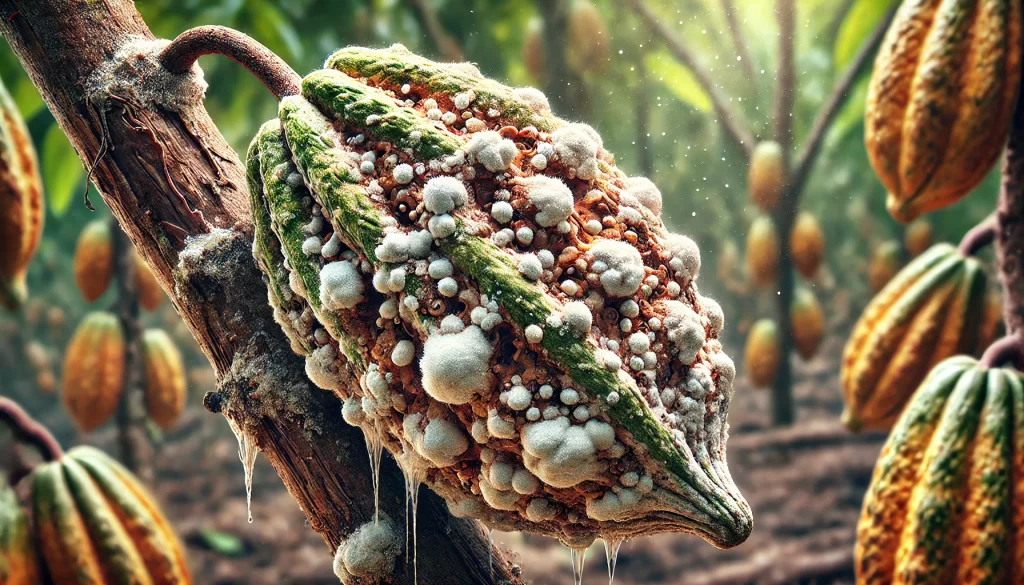
Control Strategies
- Cultural Management: Removal and burning of infected fruits to reduce the source of inoculum.
- Chemical Control: Application of preventive fungicides during the rainy season, when the disease is most active.
- Biological Control: Research and application of antagonistic fungi that can inhibit the growth of Moniliophthora roreri.
2. Witches’ Broom (Moniliophthora perniciosa)
Description
Witches’ broom is one of the most devastating diseases of cacao, characterized by the formation of deformed shoots known as “brooms.”
Symptoms
- Abnormal and deformed shoots that resemble brooms.
- Wilting of flowers and fruits.
- Significant reduction in production.
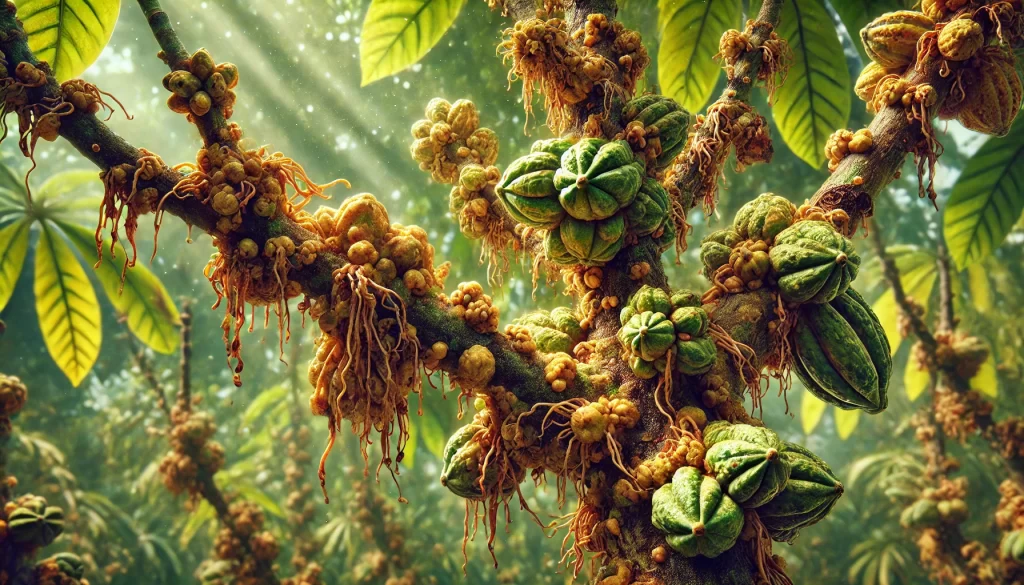
Control Strategies
- Cultural Management: Regular pruning to remove brooms and improve air circulation in the crop.
- Chemical Control: Application of systemic fungicides to reduce the spread of the fungus.
- Biological Control: Use of antagonistic bacteria like Bacillus subtilis that can reduce the incidence of the disease.
3. Black Pod (Phytophthora spp.)
Description
Black pod is a disease caused by different species of Phytophthora, which affects the pods and can lead to total crop loss if not properly managed.
Symptoms
- Black lesions on pods that spread rapidly.
- Necrosis of the skin and internal rot of the fruits.
- Loss of weight and quality in cacao beans.
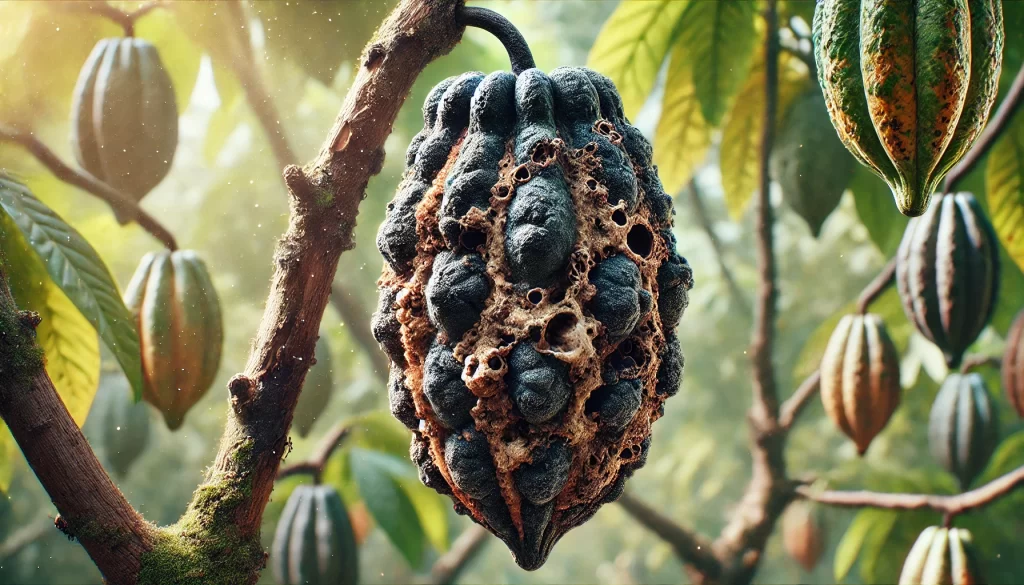
Control Strategies
- Cultural Management: Proper soil drainage to avoid waterlogging that favors the disease.
- Chemical Control: Application of copper-based or phosphite fungicides, especially during the rainy season.
- Biological Control: Use of Trichoderma spp. strains that act as antagonists to the Phytophthora fungus.
Integrated Management Strategies
Monitoring and Early Detection
Constant monitoring is key to effective pest and disease management in cacao. Regular crop inspections, especially during critical seasons, are essential to detect any early signs of infestation or disease.
Cultural Practices
The implementation of proper cultural practices, such as regular pruning, removal of infected material, and weed control, can significantly reduce the incidence of pests and diseases.
Biological Control
The use of natural enemies and biological agents is a sustainable and effective strategy for managing pests and diseases. The introduction of parasitoids, natural predators, and antagonistic fungi can help keep pest populations under control without resorting to chemicals.
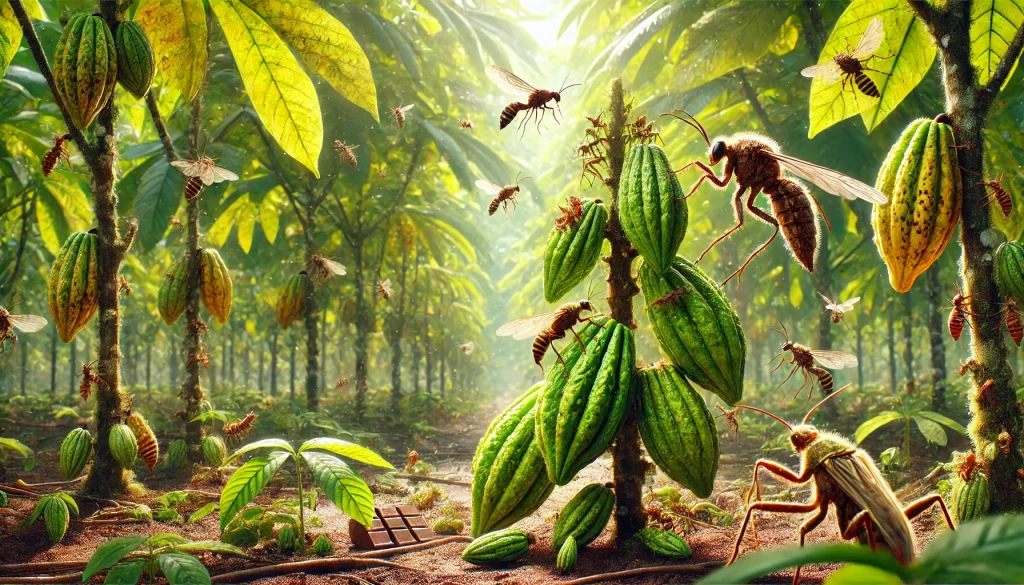
Chemical Control
The use of pesticides and fungicides should be the last line of defense, used only when pests or diseases exceed the economic damage threshold. It is essential to follow integrated pest management (IPM) recommendations to minimize environmental impact and avoid resistance to chemical products.
 AgronoBlog – Agriculture Blog
AgronoBlog – Agriculture Blog 